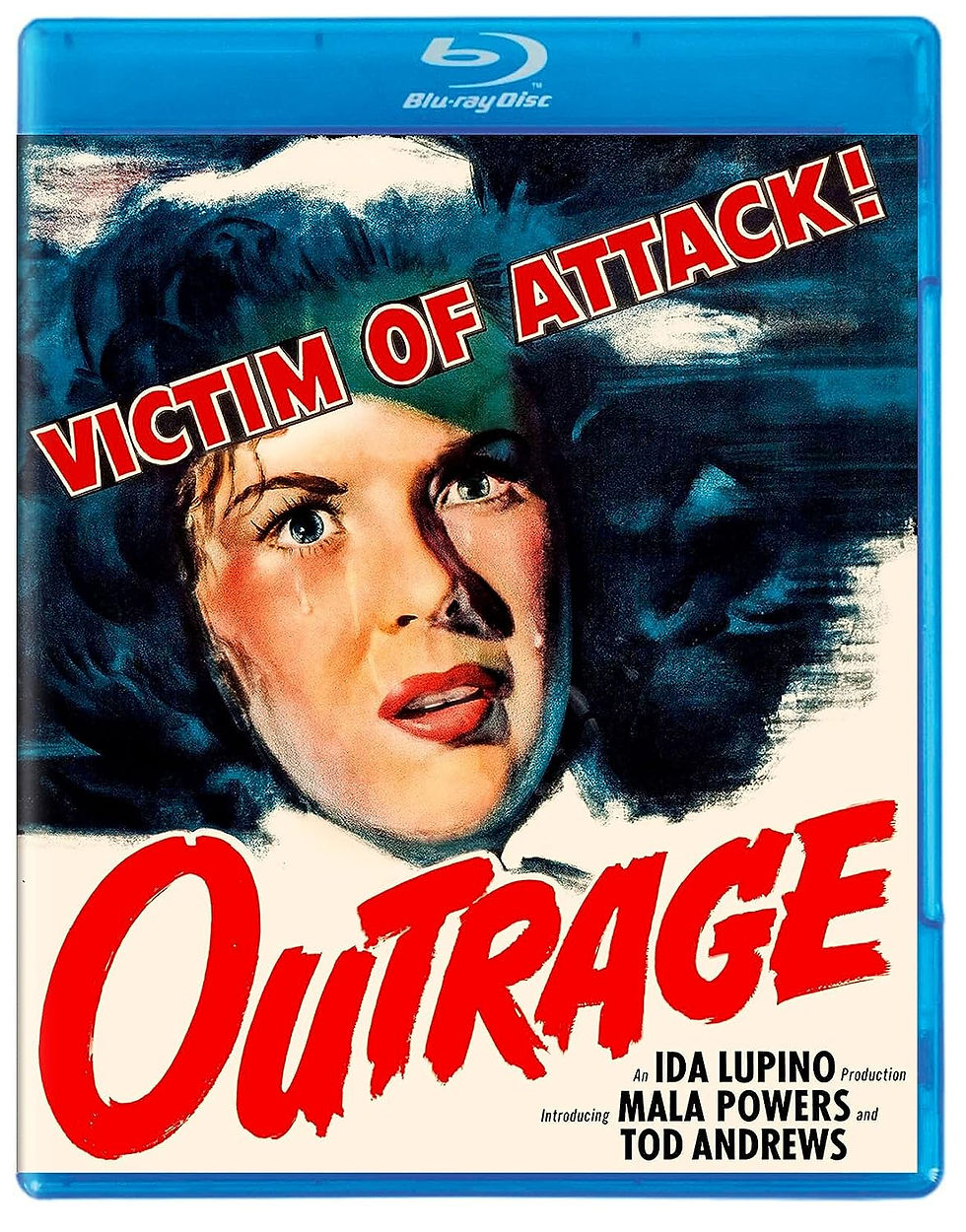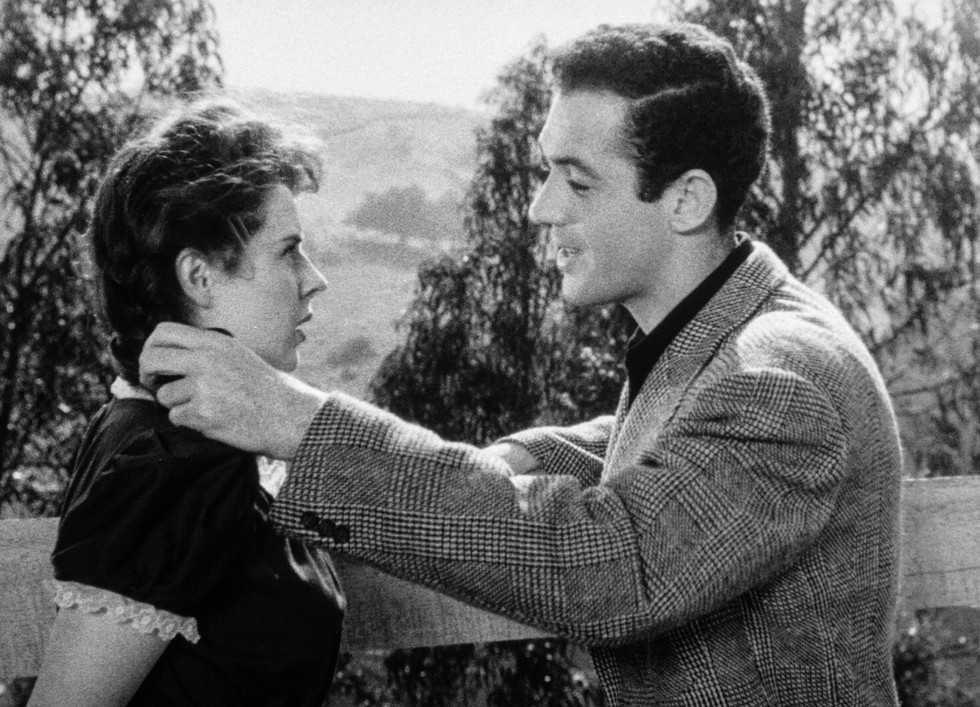Ida Lupino pushes Hays Code envelope with “Outrage”
- Peggy Earle
- Aug 18, 2023
- 5 min read
BLU-RAY REVIEW / FRAME SHOTS

18-year-old Mala Powers, a newcomer to Hollywood plays Ann Walton, who’s raped after a late night at work.
(Click an image to scroll the larger versions)
“OUTRAGE”
Blu-ray; 1950; Not Rated
Best extra: The one extra is a commentary by film historian Imogen Sara Smith
IDA LUPINO, who most people know as a fine actress, was also an accomplished director, writer, producer, and composer, at a time when those titles were almost unheard of for women in Hollywood. She had her own production company, “The Filmakers,” with her then-husband Collier Young. The subjects of her films tended to be ordinary people – particularly women – and various challenges that alter their lives.
“Outrage,” Lupino’s third feature, is the story of Ann Walton (Mala Powers), a young, recently engaged bookkeeper in a small Midwestern town. After working late one night, Ann is stalked and raped by a man (Albert Mellen) who runs a food truck at the plant where she’s employed. The rest of the film examines the effects of the attack on Ann. Her trauma, exacerbated by her clueless fiancé (Robert Clarke), her self-centered father (Raymond Bond), and her insensitive co-workers, leads her to run away and change her name. She takes a bus to California, where she eventually collapses along a highway, and is discovered there by Bruce Ferguson (Tod Andrews), a handsome young clergyman. Bruce scoops Ann up and drives her to the home of friends, who take care of her. The friends have an orange plantation, where Ann is eventually employed and, seemingly, recovers as her invented incarnation. Naturally, this doesn’t last, and flashbacks bring on a different sort of violent episode. Bruce learns of Ann’s history and real identity and continues to be her champion, suggesting feelings that run deeper than friendship.
Produced during the period of the “Hays Code” – from the 1930s to the 1960s – which censored Hollywood films for what was deemed “unsuitable,” “Outrage” manages to just barely stay within its parameters. For example, the initial attack on Ann is not shown on screen, and the word “rape” is never spoken, referred to only as a “criminal assault.”
Love & Work
(1) The low-budget “Outrage” was an independent production released by RKO Pictures and opened in New York City in October 1950. (2-4) Ann gets a box lunch for herself and her fiancé Jim Owens (Robert Clarke) from a food truck outside the Bradshaw Mill Company factory. The happy couple enjoys their lunchtime together. (5) After work the couple announces to her parents they are ready to get married.
VIDEO/AUDIO
Touted with a new 4K scan of the best 35mm fine grain elements (1.37:1 aspect ratio) from Paramount Pictures, we’ve come to expect excellent digital restoration from them. However, this KL Studio Classics Blu-ray shows a very different look. From start to finish, there are marks and scratches from the source material, implying Paramount forwarded the 1080p encoding without any digital cleanup.
The overall clarity is still quite good with plenty of depth. The grayscale is well balanced from highlights to mid-tones and solid shadows with expressionist lighting from cinematographer Archie Stout (“Angel and the Badman,” “Fort Apache”). Still, with all the marks it’s like going back in time to a 1970s movie theater with its old-school 35mm projector, where the print is clearly showing some wear and tear.
The audio track is flawless, with dialogue always clear and sound effects realistic. The spare score, is composed by Paul Sawtell, but tense moments, shot without music, makes scenes even more powerful.
The Late-night Attack
(1) The next evening Ann works late and departs the office while the food truck
attendant closes up. (2-6) The unnamed character spots Ann and the violent nightmare starts. Film Historian Imogen Sara Smith says during her commentary, the scene is an homage to Fritz Lang’s German expressionist “M” (1930), where the city of Düsseldorf is terrorized by a child murderer.
EXTRAS
Imogen Sara Smith’s commentary is especially good, full of interesting background and trivia, and never bogged down with exposition. The author of a book about film noir, Smith calls “Outrage” “noir-adjacent.” It wasn’t the first film to include a rape, but it was the first to “explore the psychological effects” of such an assault, as well as “society’s response” to it. Smith discusses Lupino’s focus on the “emotional landscape of post-war America” in her work – and describes how she “rebelled against the dream factory.” The director chose projects that dealt with “contemporary social problems, especially taboos … in which lives are violently interrupted, and then how they are healed and reintegrated into society.”
An “economical director,” Lupino made her movies on very small budgets. She would repurpose sets and use simple, but effective, visual devices – such as hard shadows to suggest danger, much like the German expressionists. Smith points out the various ways Lupino visually suggests Ann was trapped by her life and her assault – and praises her “distinctive visual style,” which included deep focus and mise-en-scène. Lupino, says Smith, loved discovering and developing new talent, pointing out that Mala Powers was only 18 for her debut appearance in “Outrage.” Lupino was also interested in having diversity in her films, and “had to fight” to have an African American actor play a policeman in the film.
Smith addresses the more recent criticism Lupino has received for not doing enough to fight the male-dominated Hollywood system. But Smith insists the director was “strong-willed, but also willing to play the game” in order to succeed. While making religion and male domination major factors in Ann’s healing process in “Outrage,” Lupino also has Bruce deliver a powerful speech about the failures of society (many of which still exist) that lead to violence and tragedy. And while the film’s ending may seem like a cop-out to modern viewers, Smith deftly points out details that may suggest otherwise.
— Peggy Earle
The Shocking Aftermath
(1&2) Ann arrives home and her mother (Lilian Hamilton) is shocked by her condition. (3&4) She can only remember that the attacker had a scar on his neck and wore a leather jacket. Ann and Jim attend a police lineup. (5) The aftermath is so traumatic Ann decides to leave town without a word.
A New Start
(1) During the bus trip heading to Los Angeles Ann hears a radio report about her disappearance and decides to leave. She’s found along the road by the Rev. Bruce Ferguson (Tod Andrews) and taken to a local farmer’s home. Ann starts working in a packing plant. (2) Bruce, a World War II veteran, takes Ann to his favorite “peaceful” spot in the Santa Paula Valley.
PTSD Overtakes Ann
(1&2) During the harvest dance, co-worker Frank Marini (Jerry Paris) flirts with Ann and tries to kiss her. She panics and uses a large wrench to hit him and races off. (3) She’s arrested, but Bruce pleads with the prosecuting attorney to dismiss the charges. (4&5) Ann must decide to either stay in Santa Paula or go back home.















































Comments